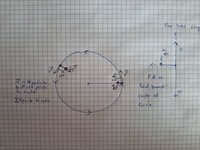I have this problem. I can't do it. I have no idea how to proceed with this.
The question:
"A machine part consists of a thin 40.0 cm-long bar with small 1.15-kg masses fastened by screws to its ends. The screws can support a maximum force of 75.0 N without pulling out. This bar rotates about an axis perpendicular to it at its center.
a) As the bar is turning at a constant rate on a horizontal frictionless surface, what is the maximum speed the masses can have without pulling out the screws?
b) Suppose the machine is redesigned so that the bar turns at a constant rate in a vertical circle. Will one of the screws be more likely to pull out when the mass is at the top of the circle or at the bottom?
c) Using the result of part b), what is the greatest speed the masses can have without pulling a screw?"
I just know that the answer to b) is the bottom.
The question:
"A machine part consists of a thin 40.0 cm-long bar with small 1.15-kg masses fastened by screws to its ends. The screws can support a maximum force of 75.0 N without pulling out. This bar rotates about an axis perpendicular to it at its center.
a) As the bar is turning at a constant rate on a horizontal frictionless surface, what is the maximum speed the masses can have without pulling out the screws?
b) Suppose the machine is redesigned so that the bar turns at a constant rate in a vertical circle. Will one of the screws be more likely to pull out when the mass is at the top of the circle or at the bottom?
c) Using the result of part b), what is the greatest speed the masses can have without pulling a screw?"
I just know that the answer to b) is the bottom.

